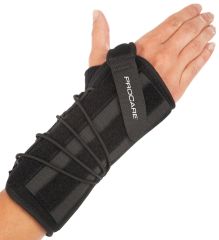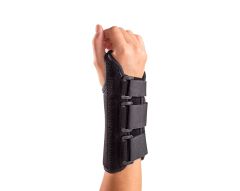Wrist Arthritis
The wrist is a very complex hinge joint that consists of 15 bones between the forearm and hand. When there is inflammation—the body’s natural way of trying to protect itself—anywhere in the wrist, it’s called wrist arthritis. There are over 100 different kinds of arthritis, but when it occurs in the wrist, it’s usually due to either osteoarthritis (OA) or rheumatoid arthritis.
What Causes Wrist Arthritis?
The 15 bones that make up the wrist include eight small bones within the base of the hand, the two bones of the forearm (radius and ulna) and the five lower bones in our hand (metacarpals). These bones all meet to form individual joints, which are connected by ligaments and surrounded by articular cartilage. This cartilage serves as a protective barrier between bones and prevents them from touching each another. In arthritis, the articular cartilage thins and wears away, which causes bones to rub too closely or directly against one another.
Wrist arthritis most commonly affects those over the age of 45 and nearly always means either osteoarthritis or rheumatoid arthritis is present. Osteoarthritis, the most common type of arthritis, usually occurs due to normal wear and tear of the joints in the wrist. This is why it’s most common in older adults, but other risk factors include wrist injuries, infections and repeatedly performing too many wrist movements. Rheumatoid arthritis is an autoimmune disease that affects the entire body, especially the joints. Autoimmune means that the body attacks its own healthy tissue, even though it poses no danger, and this causes inflammation. Rheumatoid arthritis typically begins at a younger age—approximately 20-40—in smaller joints like the wrist and hand, and its causes are unknown. Both types of arthritis occur more frequently in women than men.
What are the Symptoms?
The most common symptom of osteoarthritis is pain in the wrist. This pain usually gets worse when performing movements like turning a door handle, opening a jar or during gripping sports like tennis and golf, but it may be relieved with rest. Some patients will also experience swelling, tenderness when the wrist is touched, or lose their ability to move the wrist well. As a result, the pain and loss of motion can lead to weakness in the wrist, which makes it difficult to perform certain tasks. Symptoms are mainly similar in rheumatoid arthritis, but there may also be some stiffness in the morning, general discomfort, and pain and swelling in the knuckles as well.
What is the Treatment?
For some people, pain from wrist arthritis will eventually go away if they avoid certain painful activities. In other cases the pain can get much worse and cause serious complications. This is why it’s important to see a doctor if you’ve been experiencing pain and other symptoms in the wrist for a while. The doctor will perform a physical examination, ask you a series of questions and use some tests to help determine what’s causing the pain. An X-ray may also be used to distinguish between different types of arthritis, and blood tests are given in some cases to diagnose rheumatoid arthritis. If wrist arthritis is found to be present, treatment will most likely be conservative (non-surgical), and your doctor will usually recommend the following:
Education and Activity Modification
If certain activities make your pain worse, you should limit or stop them; your doctor will help you find ways to adjust certain activities so you can perform them, but with less pain.
Immobilization
Using a splint, support or brace to protect the wrist and prevent it from moving too much, and can help relieve symptoms; the DonJoy Wrist Wraps and ComfortFORM Wrist Support are for this purpose and may be recommended by your doctor.
Ice/Heat Therapy
Your doctor may instruct you to apply ice or heat to the wrist for a certain period of time to reduce pain and swelling.
Physical Therapy
A physical therapist can help create a treatment program for your wrist arthritis that will likely include the above interventions, as well as massage, stretching exercises and strengthening exercises.
Medications
For rheumatoid arthritis, treatment must also include the use of medications that slow down the progress of the disease.
Cortisone Injections
If pain is constant—even at rest and/or at night—cortisone injections may be recommended; this is a powerful, anti-inflammatory medicine that’s injected directly into the wrist to relieve symptoms
Surgery
When these measures fail to relieve symptoms of carpal tunnel syndrome, surgery may be needed. The surgical procedure for this condition is called carpal tunnel release, which opens up the carpal tunnel in order to relieve pressure on the median nerve. Physical therapy is often needed after surgery as well to help restore strength and modify habits that led to symptoms in the first place.
Can Wrist Arthritis Be Prevented?
Although wrist arthritis often develops for reasons we either don’t understand or don’t have control over—like aging—there are some ways to reduce the chances of developing it. Here’s how:
- Try to avoid or limit the amount of time that you perform repetitive movements of the wrist, such as using vibrating tools
- Take regular breaks when performing any activity that requires wrist movement and stretch your wrist(s) thoroughly
- Perform exercises to help you build and maintain the strength of your hands and wrists; a physical therapist can help guide you with this process, which may include the use of therapeutic putty or hand therapy balls







